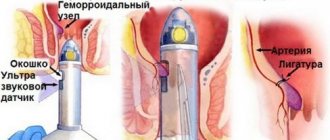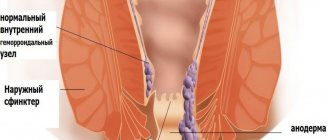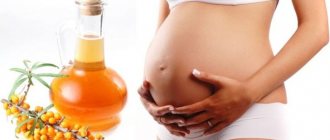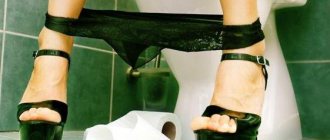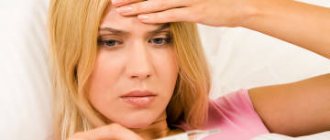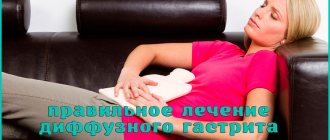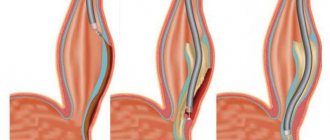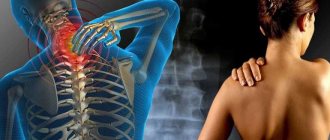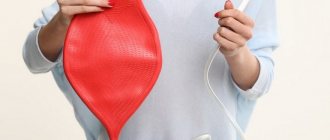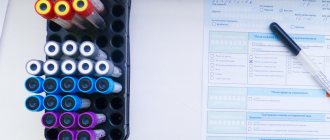Hemorrhoids (hemorrhoidal lumps) are an important indicator that internal hemorrhoids are progressing and moving into advanced stages. With external hemorrhoids, external nodes form immediately. What is it, why do they form and how to treat such formations?
External hemorrhoids are found in the early stages of hemorrhoids, while internal hemorrhoids may only be visible when they fall out
Hemorrhoids are an extremely common disease that can develop in a person of any age, gender and occupation. One of the problems contributing to the development and progression of hemorrhoids is late diagnosis. As a rule, patients do not attach much importance to the symptoms of hemorrhoids in the early stages until nothing hurts, and many do not find the time or are embarrassed to see a doctor even in the later stages of the disease. Meanwhile, it depends on how early hemorrhoids were diagnosed, which methods and how long the treatment will have to be carried out, as well as whether it will be possible to get rid of hemorrhoids at home, or whether home methods will only be able to temporarily reduce the symptoms.
The discrepancy between the influx of arterial blood to the cavernous bodies and the outflow of venous blood from them leads to an increase in choroid plexuses and weakening of the vessel walls, an increase in the number of arteriovenous anastomoses, and the formation of nodes from hemorrhoidal veins.
What kind of disease is this?
Small hemorrhoids are a venous collection of vessels located inside the rectum or outside in the anus. In the absence of obvious irritants, education is not bothered. They are necessary for the normal excretion of feces; if the outflow of blood is disrupted, the arterioles enlarge and form cones. There are many reasons that influence the progression of the disease. They become engorged with blood and increase in size, then the sphincter muscles weaken and hemorrhoidal prolapse occurs. At first, the knots are soft to the touch and tighten on their own; after a while, the prolapse becomes more frequent; they can be adjusted with a finger. When the first symptoms appear, consult a proctologist, since in advanced stages of the disease, the optimal solution would be excision of the cones.
Types of hemorrhagic nodes
Nodes are distinguished by location, they are:
- Internal bumps. Covered with a mucous membrane, under the protective layer there is connective and muscle tissue, enveloped in venous accumulation.
- The external nodes are identical in structure to the internal ones and appear near the anus. The membrane of the node is covered with multilayered epithelium, which becomes thinner after being filled with blood.
- Combined. Multiple hemorrhoids that are located in the inside of the rectum and outside.
Causes
There are many provoking factors that contribute to the development of external hemorrhoids. All of them are hypotheses that have not achieved scientific confirmation. Common causes of the disease:
The cause of the disease can be a sedentary lifestyle.
- Frequent constipation. The mucous membrane of the lower rectum is injured, the accumulation of feces exerts pressure, and the person makes efforts to defecate. This happens due to poor nutrition - fast food, dry food, sweet carbonated drinks.
- Passive lifestyle. There is no outflow of blood from the pelvis.
- Work involving heavy weight.
- Drinking alcoholic beverages, which lead to dilation of the venous cavity.
- Spicy, sour, salty foods irritate the walls of the anus during bowel movements.
- Genetics. A predisposition to the development of hemorrhoids occurs during fetal development.
- Use of laxatives.
Prevention measures
To prevent the development of hemorrhoids in the rectum, it is advisable to adhere to the following recommendations:
- Watch your diet. To do this, it is better to completely exclude the following foods from your diet:
- coffee;
- alcoholic drinks;
- hot sauces and spices;
- ketchup and mayonnaise;
- smoked meats and sausages;
- salty fish;
- sour fruits;
- semi-finished products;
- confectionery products (sweets, cakes, etc.).
The basis of the diet should be:
- dried fruits and decoctions from them;
- fermented milk products (cottage cheese, kefir, fermented baked milk, cheese);
- porridge;
- vegetable soups;
- vegetables;
- fruits;
- greenery;
- eggs;
- liver (in small quantities).
- It is imperative to quit smoking.
- When working sedentarily, you can use special inflatable rings that need to be placed under the buttocks. They will reduce pressure on the pelvis and protect against the development of hemorrhoids.
- Avoid constipation, and if it occurs, be sure to treat it.
- If you have hemorrhoids, you should not ride a horse or ride a bicycle. Instead, you can swim and do gymnastics.
- It is important not to overeat.
- You should not sit on the toilet for a long time, as such a habit will strain the rectum.
- Maintain proper hygiene of the genitals and anus.
- Avoid stress and nervous tension.
- Avoid sexual intercourse through the anus.
Symptoms of a nodule
Symptoms of the disease differ depending on the location of the hemorrhoids. At the development stage, a person is not even aware of pathological processes in the body, since the size of the formation is insignificant. Symptoms indicating the development of hemorrhoids:
- sensation of a foreign object in the anus;
- feeling of intestines not being completely defecated;
- burning and itching, the nodes secrete a secretion that causes irritation;
- pain during bowel movements;
- enlarged hemorrhoids, frequent bleeding;
- in later stages, a black spot may appear on the outer node;
- knots falling out.
Infringement
As a result of spasm of the anal sphincter, the prolapsed hemorrhoids become pinched, which is accompanied not only by severe pain, but also by disruption of blood flow in the cavernous vascular tissue, as well as:
- heavy bleeding;
- a growing feeling of discomfort inside the anus;
- inflammation and swelling of hemorrhoids, which leads to an increase in overall body temperature;
- a change in the color shade of the cones, which turns burgundy, and with necrosis - bluish-black.
Infringement of hemorrhoidal nodes is observed quite often at the last stage of the disease.
Infringement of the hemorrhoidal node goes through certain stages in its manifestation:
- The prolapsed formations are accompanied by minor bleeding. Their increased size prevents them from returning to the anus.
- Reduction of the formations is not possible; they look like “clusters” surrounding the anus. There is a risk of developing acute thrombosis.
- The bumps do not return to their original place by any means, and are also subject to an inflammatory process involving adjacent tissues. Bleeding becomes profuse, pain becomes pronounced.
- The occurrence of necrotic processes in strangulated formations leads to tissue death.
Strangled nodes with hemorrhoids require the use of complex therapy aimed at:
- to eliminate inflammation;
- normalization of blood flow;
- preventing the risk of necrosis of pathologically altered tissues.
Reduction of hemorrhoids at home is prohibited. The procedure is performed in a hospital using local anesthesia, after swelling, inflammation and pain have been eliminated.
Diagnostic methods
For a more detailed study of the rectal mucosa, they resort to rectoscopy.
If you have hemorrhoids, it is extremely important to consult a proctologist who will conduct an examination and draw up a treatment plan. First, the patient's medical history is studied and the tissues around the anus are examined. If there are external nodes, their nature and size are studied. Next, the inner walls of the rectum are palpated to ensure that there are no internal growths. You can't do without rectoscopy; a long tube with a small camera at the end is inserted through the anus. This is necessary to study the entire intestinal mucosa, since the nodes can be localized in hard-to-reach places.
Stages of development and complications of the disease
The progression of external hemorrhoids goes through several successive stages.
There are three degrees of appearance of the disease that occur after an active inflammatory process:
- intense pain, burning, itching, especially noticeable when eating fatty, spicy, smoked foods. Inflamed hemorrhoids are enlarged, dense to the touch, the anal area is red, slightly swollen;
- as the inflammatory effect increases, swelling and redness increase, and pain intensifies. Sometimes it is impossible to touch the nodes due to throbbing pain. This state of affairs indicates thrombosis of the node. Thrombosis occurs when a blood vessel is blocked by a blood clot. The outflow becomes significantly more difficult, the vessel fills with blood and becomes inflamed;
- A complication of stage 3 of the disease is further deterioration of the vascular condition. Inflammation spreads to surrounding tissues. In this case, external hemorrhoids look like a dense red-blue grape protruding from under the skin.
The acute stage of the disease, with inadequate treatment or lack thereof, becomes chronic. The chronic course is characterized by muted symptoms, alternating with periods of exacerbation and temporary improvement of the condition. During an exacerbation, swelling and soreness of the perineum, bulging of nodes, and increased body temperature are observed.
Treatment of hemorrhoids
The doctor selects treatment methods based on the stage of the disease and the general condition of the patient. It is not enough to remove painful symptoms; for recovery it is important to eradicate the cause. Complex therapy will help cope with a big problem. Common treatments:
- conservative therapy (medicines) in the initial stages can cure inflamed nodes;
- traditional medicine - medicines of healers that can be used as an addition to treatment;
- surgical removal is a radical way to combat hemorrhoids, used when the size of the nodes is huge and interferes with the passage;
- minimally invasive methods are quick, effective ways to overcome the disease with minimal risks.
Medicines
The medications that are most often prescribed for the treatment of hemorrhoids are described in the table:
| Name | Action | Release form |
| "Detralex" | Reduces blood stagnation | Pills |
| Promotes tissue regeneration | ||
| "Antrasenin" | Laxative, radar | |
| "Ginkor forte" | Tones blood vessels | Rectal suppository |
| Improves blood flow to the pelvis | ||
| "Pylex" | Anti-inflammatory | Tablets, capsules |
| Painkiller | ||
| "Proctosedyl" | Prevents the formation of blood clots | Ointment |
| "Proctazan" | Healing | |
| Local antiseptic |
Surgical removal
The advanced form of the disease is treated with hemorrhoidopexy.
The doctor prescribes surgery in extreme cases when there is a high risk of complications. In addition, the fallen nodes do not heal and reach a huge size. Initially, a black dot appears, then tissue necrosis; it is impossible to cope with the problem on your own. A characteristic blue or black color with tissue necrosis and unbearable pain that occurs at the slightest contact. Bluish hemorrhoids are treated by removing part of the flesh and venous collections underneath them. In this situation it may help:
- Hemorrhoidectomy. Provides for the removal of cones that have fallen out or internal formations along with a section of the intestinal mucosa and vascular canals. When completed, the wound may remain open or closed (with stitches), and possible rejection. The operation takes place in a hospital, and after a few days the patient goes home.
- Hemorrhoidopexy (Longo operation). It is performed under general anesthesia for painless insertion of surgical instruments. Hard nodes are not removed; they gradually go away, the supply channel, large and small blood vessels are blocked. Natural mechanisms are not disrupted.
In the chronic form, surgery is the only method to get rid of hemorrhoids forever. After the manipulation, the risk of relapse is negligible.
Minimally invasive interventions
If the node is swollen and painful, and medications are ineffective, then minimally invasive techniques will come to the rescue:
One of the commonly used methods for removing nodes is disarterization.
- Sclerosis. It consists of injecting the medicine into a hard node, then the walls of the blood vessels stick together and the swelling goes away. It becomes soft and disappears after a few days.
- Tightening with latex rings. A latex ring is placed on the node’s stem, the blood flow is stopped, and the formation decreases immediately after manipulation.
- Laser coagulation. With the help of streams of rays of different frequencies, a huge breakthrough is removed. Blood vessels are cauterized, there is no bleeding.
- Desarterization. Ligation of blood vessels.
- Cryodestruction. Burning with liquid nitrogen.
- Thrombectomy. A plaque filled with blood is removed using this method; if the blood clot comes off, another manipulation is performed in parallel.
ethnoscience
Traditional medicine recipes are effective in complex therapy. It is dangerous to treat exclusively with these methods; the formation will stop hurting for a while, but the process of developing the disease will continue. Possible procedures that can be done at home:
- baths;
- lotions and compresses;
- herbal ointments;
- douching;
- decoctions for internal use;
- cold candles.
First aid for inflammation
Using enemas will help minimize pain, relieve inflammation, and prevent constipation. A remedy for pain relief is rinsing with potato juice. You need 1 tablespoon of juice. The course of treatment is ten days.
Clyster with a decoction of wormwood helps. To prepare, you will need 3-4 tablespoons of dried herbs and a liter of water. Stir and boil for 5 minutes. Let it brew for a couple of hours. Douche before going to bed.
The first action for inflammation is to take a sitz bath. Alternating cool and warm water helps. For preparation you will need medicinal herbs: chamomile, sage, oak bark. Disinfect the inflamed area from germs.
A well-known remedy for hemorrhoids is salt baths. 5-6 grams of sea salt per liter of water. Take a bath 2-3 times a day for 20 minutes. Warm water is used. The pain goes away in a couple of days, and in a week you will achieve complete recovery.
Another way: do 30 baths - one per day. The concentration of salt in the water is like that of over-salted soup. Stay in warm water for 5 minutes on the first day, 10 minutes on the second, 15 minutes on the rest.
A burdock bath will help get rid of the disease forever. Wash 10 burdock leaves, pour in 4 liters of water, boil, let it brew. Pour the warm solution into a basin and sit on the leaves. In a sitting position, freeze until the water cools. The next day, heat the solution and repeat the steps. Take a bath for 5 days in a row.
Traditional Treatments
Suppositories, ointments, tablets are used after detailed reading of the instructions due to side effects. The ointment is applied to the hemorrhoid using cotton wool.
- Levomekol – relieves inflammation of hemorrhoids and has antibacterial properties. It should be applied to the affected area of the body 4-5 times a day.
- Bezornil - dries out inflamed areas of the intestine, regenerates infected tissue. Apply to the affected area externally or internally using an applicator.
- Fleming's ointment - acts as an anesthetic, absorbable agent.
The drugs work for external hemorrhoids. Internal hemorrhoids can be treated at home with suppositories. Made with herbs, they are not harmful to human health. Known drugs:
- Suppositories based on sea buckthorn oil - heal the tissues of the anal canal. Injected 3-4 times a day.
- Suppositories based on propolis - slow down the inflammatory process, regenerate the affected areas of the walls of the rectum. Antiseptic effect.
- Suppositories with ichthyol - regenerate intestinal microflora.
- Posterizan - enhances the immune system, slows down the inflammatory process of hemorrhoids.
To get rid of hemorrhoids faster, treat from the inside. Drugs that improve blood circulation in hemorrhoids:
- Detralex tablets - increase the tone of the vascular system and improve well-being.
- Venarus - improves blood circulation in the vessels.
- Proctoglivenol - strengthens the walls of the rectum.
If you take tablets, suppositories and ointments in combination, you can quickly achieve the desired result
It is important to follow the warnings written in the instructions, otherwise a relapse will occur
Possible consequences
If the disease is ignored, it can be complicated by an anal fissure.
The consequences of hemorrhoids can be hazardous to health. Ignoring the disease will lead to cracks in the anus, increasing the chances of infection. Black purulent ulcers may appear at the site of the lesion. The structure of the node allows for filling with blood with poor blood outflow, they hurt and bleed, and in some cases, blood loss is life-threatening.
Folk remedies
Folk remedies can be effective if small hemorrhoids come out. There are a large number of alternative medicines that can be prepared at home, significantly saving money and time on trips to the pharmacy. If hemorrhoids are severe, it is better to use traditional therapy in combination with traditional medicine. If the anus hurts and a lump constantly pops up, the following remedies can help:
- Herbal decoction. Sage, chamomile, calendula, plantain, nettle, St. John's wort - these products are suitable for baths, compresses and for oral administration.
- Ice helps relieve pain.
- Potato and honey suppositories will help in the first stages of the disease.
Therapeutic exercise helps with the problem, yoga is considered especially effective. In order to save yourself from the need to deal with hemorrhoids that pop out, you need to eat right, stop drinking alcohol, and lead an active and healthy lifestyle. You can take any medications only as prescribed by your doctor to avoid allergic reactions.
Preventive recommendations
To ensure that the swelling goes down and large or small hemorrhoids no longer appear, carry out preventive procedures. Normally, a person should eat 5-6 times a day and drink 2-2.5 liters of water; such a diet will help avoid constipation and restore normal digestion. If a soft knot forms when lifting a load, you should change the type of activity to a more suitable one. After the operation, follow the doctor's instructions; this requires disinfectants and constant dressings. Treating the consequences is more difficult than preventing the development of the disease.
If thrombosis occurs
When inflammation begins, thrombosis occurs. React quickly. There are two solutions: conservative and surgical.
From the moment of thrombosis, the patient limits his movements. You can't drink alcohol. It is recommended to start a diet that excludes spicy, salty, sour, and sweet foods. Food additives and fast foods are dangerous.
Warm baths and lotions are recommended to reduce symptoms and resolve. The goal of treatment is to reduce pain, relieve swelling, and make blood clots melt. The complex of therapy includes medications: sedatives, absorbents, anti-inflammatory. Antibiotics are often prescribed. Assessment of the condition of hemorrhoids is incurable - surgical intervention should be performed.
